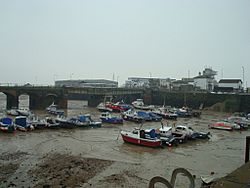Folkestone Harbour facts for kids
Quick facts for kids Port of Folkestone |
|
|---|---|
 |
|
| Location | |
| Country | United Kingdom |
| Location | Folkestone, Kent, England |
| Details | |
| Opened | 1807 |
| Owned by | The Folkestone Harbour Company |
| Size | 35 acres (14 hectares) |
| Website Folkestone Harbour |
|
Folkestone Harbour is the main port for the town of Folkestone in Kent, England. It has a long and exciting history, changing from a small fishing spot to a vital link during wars and a busy ferry terminal. Today, it's being transformed into a new place for people to enjoy.
Contents
History of Folkestone Harbour
Early Challenges and Fishing Life
Back in 1541, King Henry wanted to use Folkestone as a port. He planned to send supplies and troops from here to France. But these plans were never put into action. The king visited Folkestone in 1542, but then moved on, and the harbour idea was dropped.
In 1703, a big storm hit Folkestone. It swept away fishing boats and damaged houses. An engineer suggested building three stone walls, called jetties, to protect the cliff. Fishermen spent a lot of money on this work. However, another storm in 1724 destroyed these jetties.
By 1790, Folkestone was a busy fishing community. About 200 to 300 men and boys worked on 8-10 large fishing boats and 30 smaller ones. They caught fish like herring, mackerel, plaice, and sole. This fresh fish was then taken all the way to the markets in London.
Life was tough for the fishermen. Storms often damaged their boats and homes. The moving pebbles also made it hard to land boats safely.
The Harbour in the 20th Century
During World War I, Folkestone Harbour became incredibly important. It was a huge departure point for British soldiers going to France. Millions of military mailbags were handled here. The harbour also helped 120,000 war refugees find safety.
In the 1920s, modern steam ships replaced the old sailing boats. These larger ships used the outer harbour. The inner harbour then became a place for smaller, private boats.
When World War II began, the port closed to regular boats. It played a key role in the Dunkirk evacuation. About 44,000 soldiers were brought to Folkestone from Dunkirk. They then boarded up to eighty trains heading to London.
After the war, in 1945, cargo services started again. Ferries began sailing to Calais in France and to Belgium. In 1946, a special ship called the SS Auto Carrier started carrying cars to Boulogne. By 1947, over 67,000 passengers had used the ferry service to Boulogne.
The 1960s were a very busy time for the harbour. Over 800,000 passengers used the ferry services. They also carried many cars and lorries. To handle more vehicles, a special ramp was built in 1971-72. This ramp allowed new ships to drive vehicles on and off easily. By 1972, the Folkestone ferry services were carrying over 1.2 million passengers and nearly a million cars each year!
Folkestone Harbour Today
In 2001, all ferry services from Folkestone stopped. At the same time, the local fishing industry changed a lot. By 2002, only about ten fishing boats were still operating from the harbour.
Since 2010, there have been big plans to redevelop the harbour and seafront. Old, unused buildings were removed in 2014-2015. The old stonework and steel on the harbour arm were carefully repaired. This area has now become a new pier and promenade for everyone to enjoy. Parts of the old fairground site are now used for parking and temporary fun activities.
There was also a plan to save the old harbour railway and its station. This railway was very important during both World Wars. It was hoped to turn it into a museum about "Leaving for War." However, the Folkestone Harbour railway station has not been used by trains since 2000. In 2014, the railway line was officially closed for good.
Gallery
-
SR BoB Class 4-6-2 no 34067 Tangmere heading from Taunton to Canterbury via Folkestone Harbour. Possibly the last steam train on this line before it is removed.
-
For the Folkestone Triennial (art show) in 2011, Cornelia Parker made a bronze statue of a mermaid - a life cast of resident Georgina Baker. Wear Bay Road is behind.









